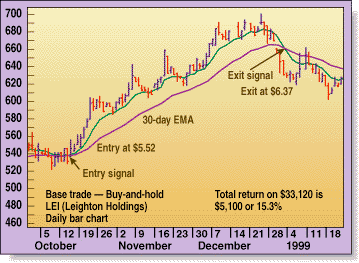BASIC TECHNIQUES
Exploiting Positions With Money Management
by Daryl Guppy
Here's a trading technique adding positions to successful trades.
Even in a bull market, there is a feeling of triumph when a trade goes our way. When this happens, the novice trader feels that getting the trade right is enough in itself and that profits will automatically follow. He is invariably disappointed when profits turn out to be smaller than expected, and often, he will redirect his attention to derivative markets to try to leverage winning trades into larger profits. This in turn exposes him to a higher level of risk than he anticipates. A better solution would be to apply money management techniques to equity markets to grow profits more effectively. This is also an important way of reducing risk.

FIGURE 1: LEI. The chart shows the progress of this successful trade. The entry is just after the 10- and 30-day moving average crossover signal, and it was made at $5.52. The exit at $6.37 is also triggered by the crossover of the 10- and 30-day exponential moving average. The return on trading capital depends on how the initial position taken at $5.52 is added to in October 1998. We buy 6,000 shares for a total cost of $33,120. If this same parcel were sold at $6.37 following a simple buy-and-hold strategy, then we collect $5,100 profit for a 15.3% return on capital employed in the trade.
Here's how risk changes, even with comparable positions and stop-loss exits. Risk, here, is trade risk, measured by the dollar loss incurred with adverse price movements. This includes both capital reduction and reduction in open profit. Risk is directly related to the money management technique selected. By comparing outcomes, the trader can exploit his winning positions more effectively. Let's examine a method to increase profits while reducing risk that I call the grow-up strategy. I use the name to distinguish it from adding to winning positions using constant dollar or constant position size.
When traders first approach the market, they concentrate on choosing the right analytical tools. They believe that if they get this right, profits will automatically follow. As time goes on, however, they realize that success is more closely tied to the way they trade and to trading discipline. They understand analysis tools are a starting point, not an endpoint. Truly successful traders take the next step by using money management to control risk.
Fund managers and institutional traders have a selection of well-defined money management formulas. Texts by Ralph Vince and Fred Gehm serve well as a good introduction to this area, but their solutions are less applicable to private traders. The private trader finds generally less information available, and even less of it applicable to portfolios at his level of capital. Take a closer look at the strategies for loading up the winners. Many trading books suggest that loading up winners is a good strategy, and because it is so self-evident, traders spend no time exploring the outcomes of their advice.
My objective is to increase the total position size as the trade continues to move in my favor. The ultimate outcome is to have most of my trading capital tied up in positions making money rather than in positions losing money.
Despite intensive analysis and research of potential and actual trading positions, many traders approach money management armed with a collection of old wives' tales. High on this list of adages is the assumption that traders improve trading outcomes by adding to winning positions. The concept is sound. The way the concept is implemented, however, is often less successful.
Most traders reach for one of two common strategies. The first is to add new positions to a winning trade of the same parcel size (that is, the same number of shares in each new position) as the initial position; the second is to add new positions that are the same dollar size. Both strategies appear successful while the trend continues, but they expose the trader to unexpected risk when the trend reverses.
Daryl Guppy is an author and a private equity and derivatives trader. He speaks regularly on trading in Australia and Asia. He can be contacted via www.ozemail.com.au/~guppy.
Excerpted from an article originally published in the September 1999 issue of Technical Analysis of STOCKS & COMMODITIES magazine. All rights reserved. © Copyright 1999, Technical Analysis, Inc.
Return to September 1999 Contents